After spending 12 nights in Albuquerque, Shae, Truffles and I made our way down to Carlsbad.
Carlsbad, NM is home to Carlsbad Caverns National Park which was our main reason for wanting to visit the area.
Considering its name, I’d figured that Carlsbad Caverns would be close to the city of Carlsbad. As it turns out, the caverns are about 30 minutes southwest of the city on the way to Guadalupe Mountains National Park, a mountain range on the border of New Mexico and Texas.
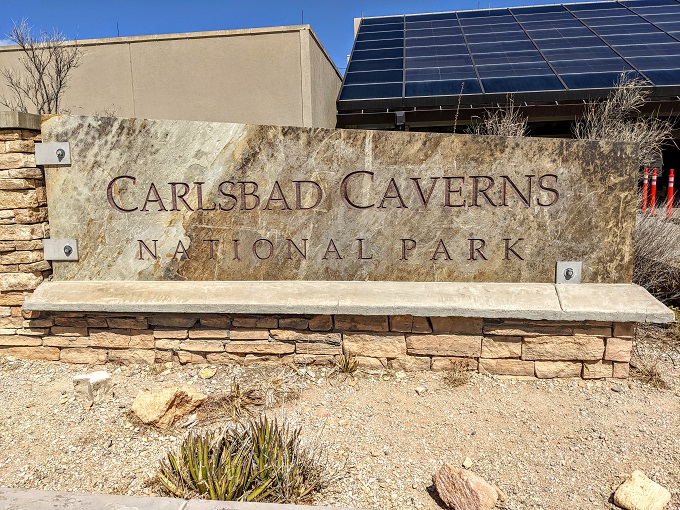
We visited Carlsbad Caverns National Park about a month or two after it reopened having been closed for some time due to COVID, so they were still limiting how many people could visit each day. We were able to book our tickets ahead of time, so be sure to check the ‘Tickets’ section at the end of the post for some important information about how that works.
After checking in at the visitor center, Shae and I walked along the small trail leading to the mouth of the caverns. There’s a paved path with switchbacks leading you deeper and deeper into the caverns. So deep in fact that you’ll eventually descend 75 stories which is the same number of stories from the ground floor to the viewing platform on the Empire State Building.
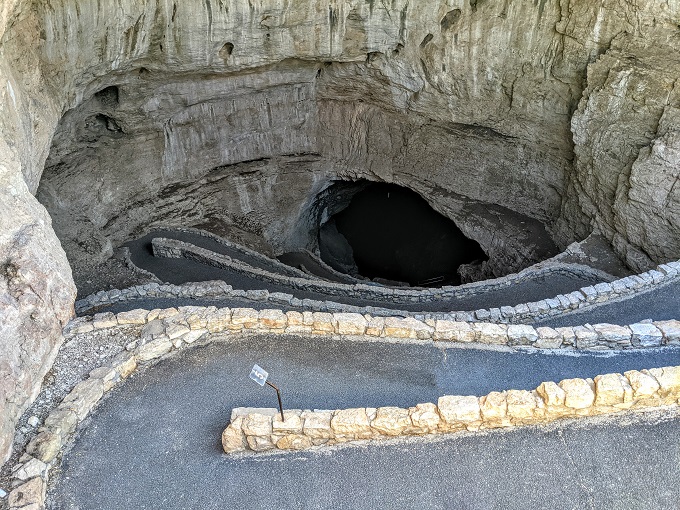
When you set off down into Carlsbad Caverns it lists the trail’s distance as 1.25 miles, but that’s not strictly true. It’s 1.25 miles down to the Big Room, but then the trail around the Big Room is another 1.2 miles, so be aware of that.
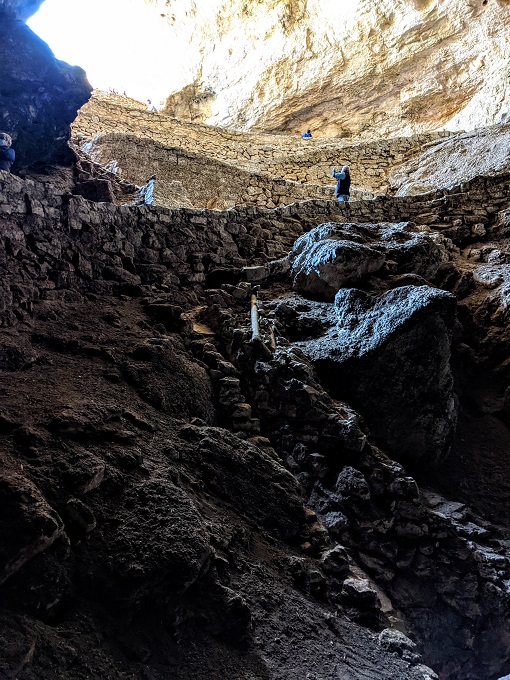
Carlsbad Caverns was discovered by teenager Jim White back in 1898. He saw bats flying out of the cave and so he went over to explore. To see how deep the hole in the ground was, he lit a dry stalk on fire and dropped it and saw it drop about 80 feet before coming to rest on rocks below.
Jim White returned later on with a ladder and lantern to explore the cavern. The photo below shows the entrance he originally used (a different one to the mouth of the caverns now used), with his ladder helping him overcome the 36 foot drop from the edge to the rocks below.
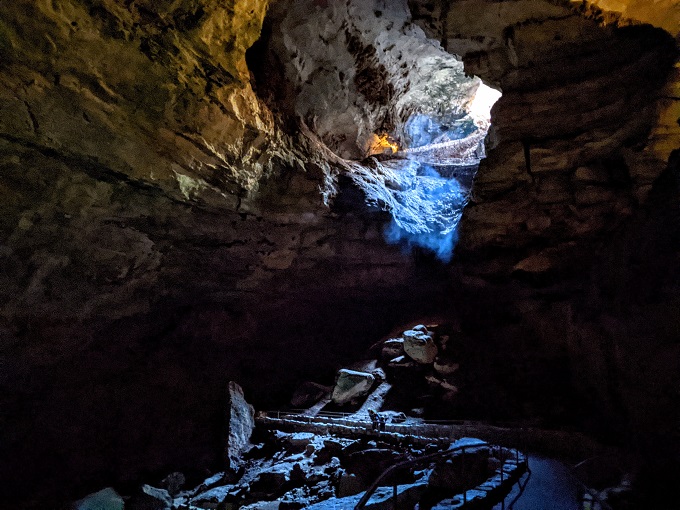
It wasn’t long before we started seeing some rock formations, with stalactites (coming down from the ceiling), stalagmites (rising from the floor) and columns (formations where stalactites and stalagmites eventually meet) all appearing along the route down.
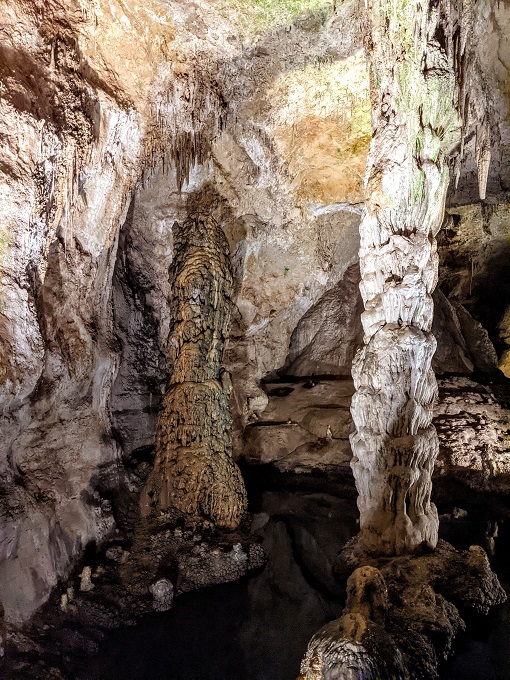
The caverns are massive, as you can see in the photo below with the path winding back and forth downwards.
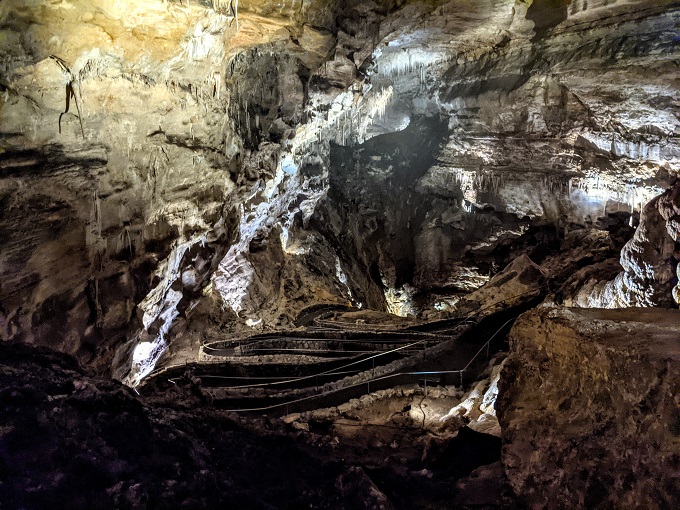
Some of the formations in Carlsbad Caverns have been given specific names, such as Whale Mouth in the photo below.
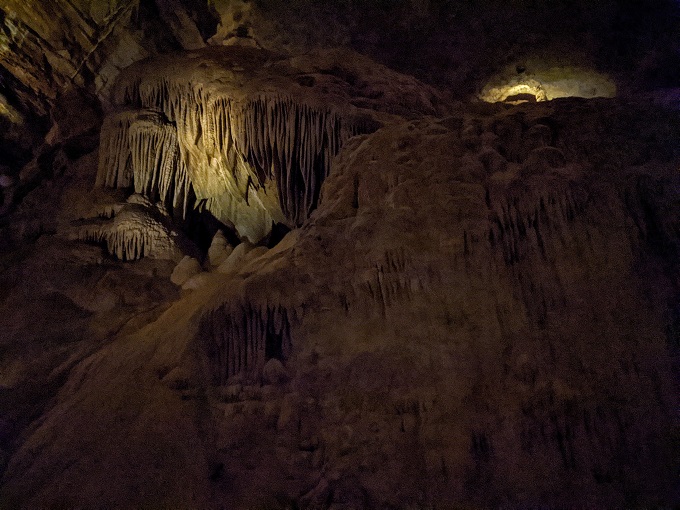
There are many formations which don’t have specific names, or not which had signs anyway. You can therefore make up your own names, so the one below I call Snoopy Sleeping.
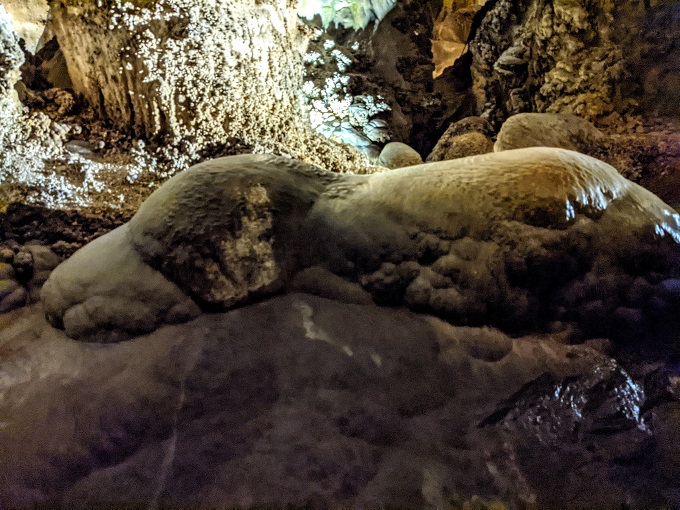
Up to 513,000 years ago, a 200,000 ton rock fell from the ceiling to the floor below. Now known as Iceberg Rock, part of the ceiling in the King’s Palace room below broke off as well as a result of the force from Iceberg Rock dropping.
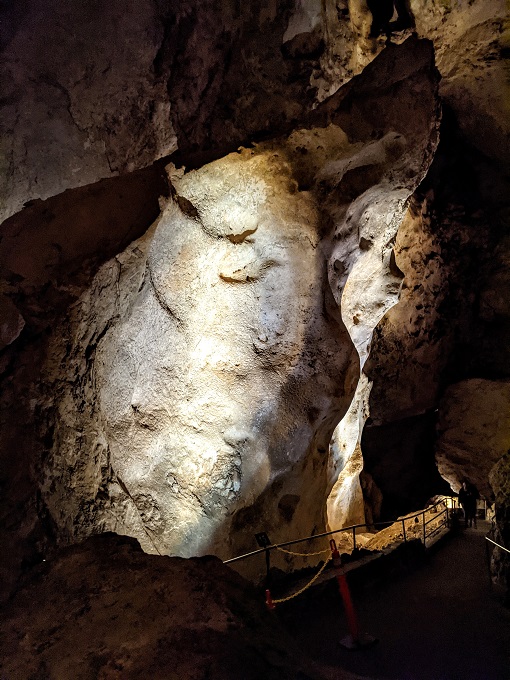
The path continues down into the Green Lake Room with lots more rock formations to see on the way down.
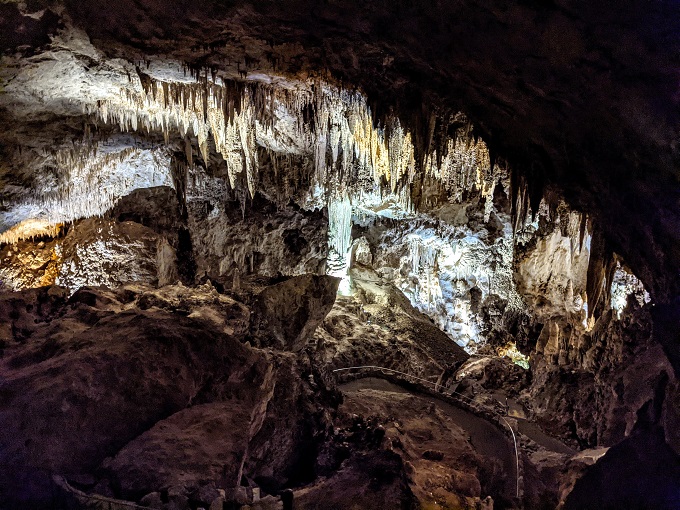
At one point we passed by some rocks that looked like Swiss cheese. Sure enough, the information board next to this section said that the Swiss cheese-like formation is called spongework or boneyard, but it’s not known for sure how it was created.
One theory is that it was caused by sulfuric acid above the water table which took place at the same time as the development of the rest of the cave. The other theory is that the process started 260 million years ago during the Permian period, with sulfuric acid subsequently enlarging it.
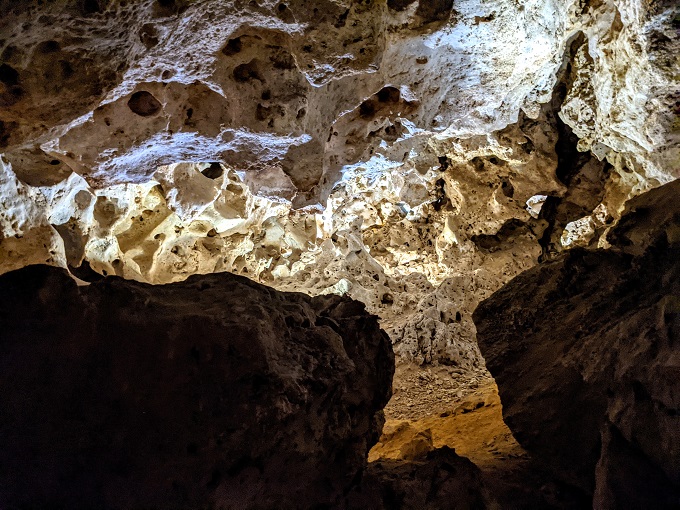
To be honest, up until this point we were both a little underwhelmed by Carlsbad Caverns. The caverns themselves were huge, but in terms of rock formations there wasn’t anything we’d seen which had anything on Luray Caverns and Grand Caverns, both in Virginia.
That is, until we got to the Big Room.
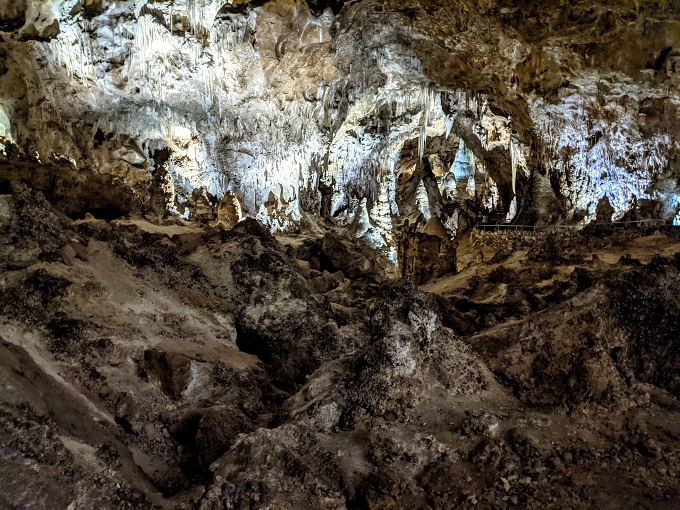
The Big Room is the largest cavern chamber in the US (that we know about), and is close to 4,000 feet long by 625 feet wide and 255 feet high at its highest point. The trail running around the Big Room is 1.2 miles long if that helps give a better sense of quite how enormous it is in there.
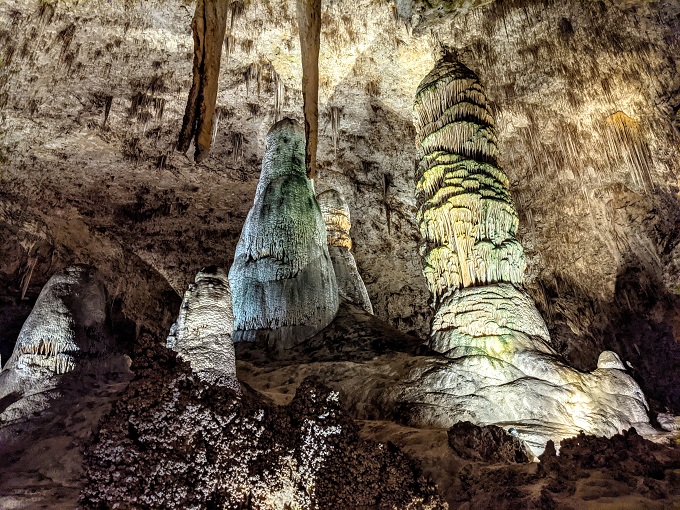
There are many kinds of rock formations inside the Big Room, including some stalactites and stalagmites that are almost touching. Despite how close their tips are to each other, it’ll likely be thousands of years before these join up to officially become a column.
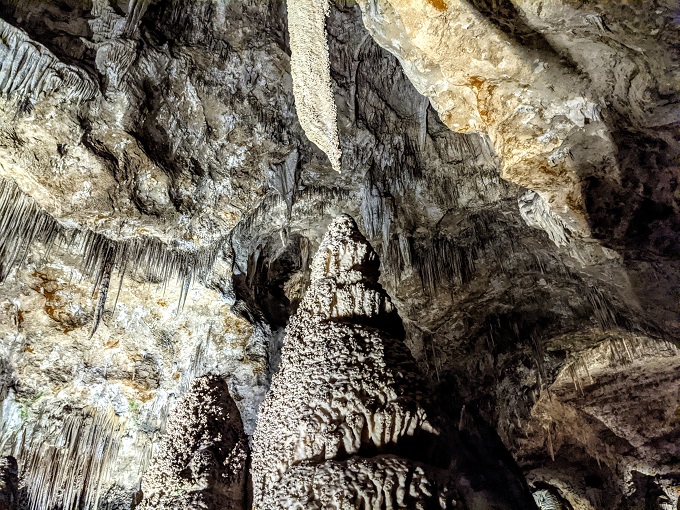
Another formation was Fairyland, a collection of stalagmites which look like popcorn.
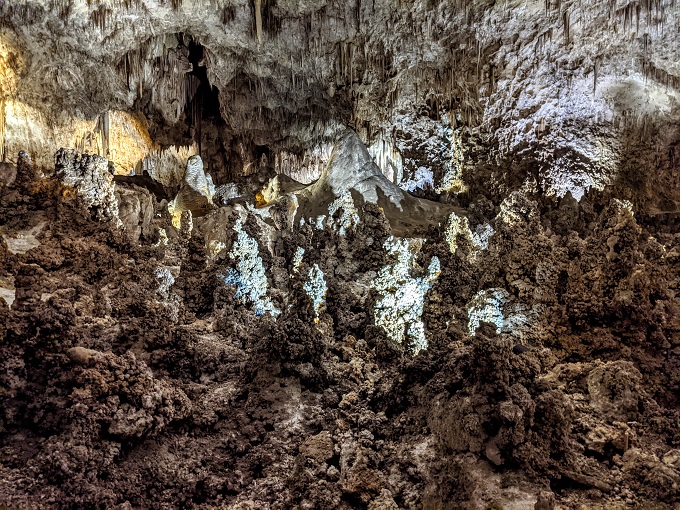
These were formed by the stalactites and soda straws on the ceiling above. With water from all of those dropping on the ground below, popcorn-style formations grew on all the surfaces.

Other formations included Temple of the Sun, Chinese Theater and Crystal Spring Dome.
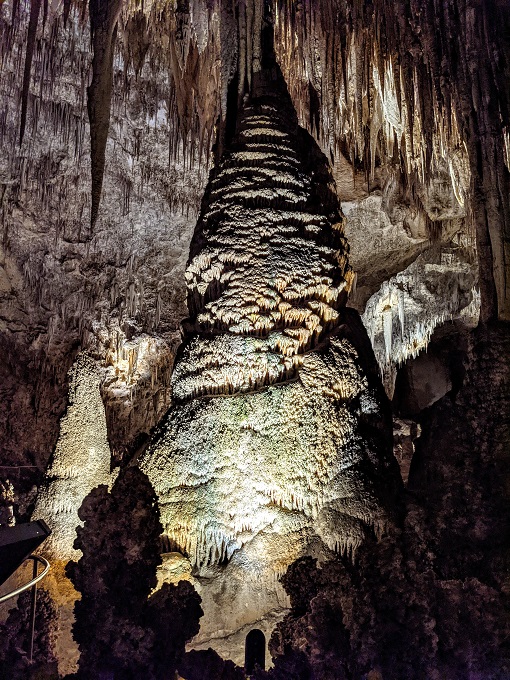
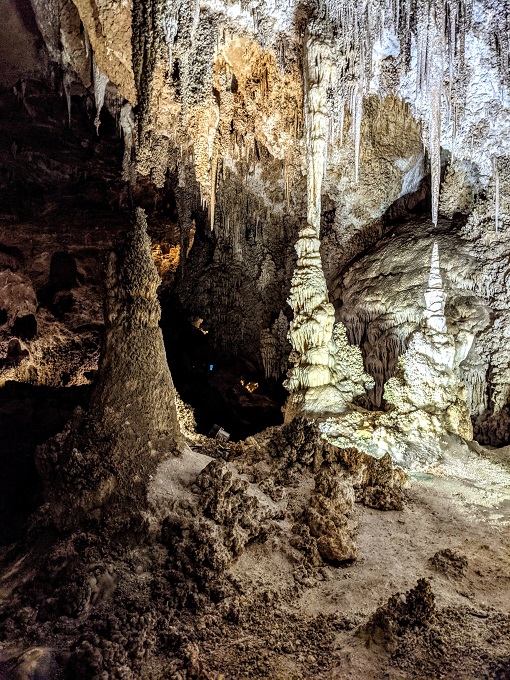
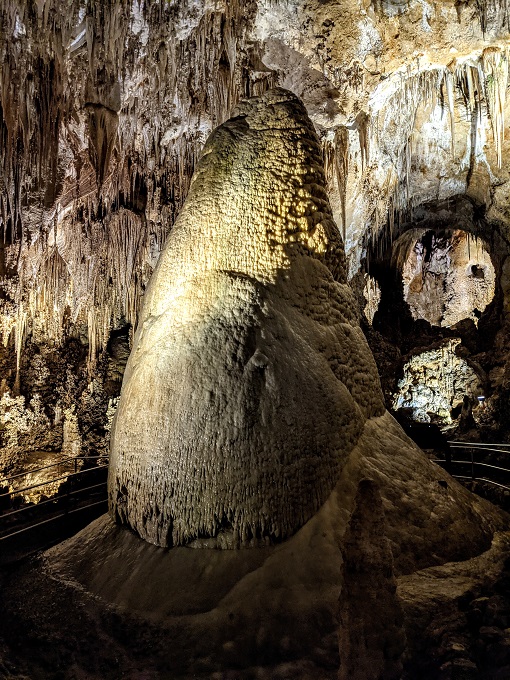
Crystal Spring Dome is the largest active stalagmite in Carlsbad Caverns. In addition to being the largest active one, it has another interesting feature which is its bell canopy at the bottom. An information board explained how this feature was formed:
The pool below the stalagmite was once as high as the shelfstone between the trail and the formation. As water flowed down the stalagmite, shelfstone reached out from the base if the water was still. But drips continually disturbed the water surface. The shelfstone couldn’t grow. The calcite backed up to the stalagmite, building a ramp with a flat bottom, much like a bell.
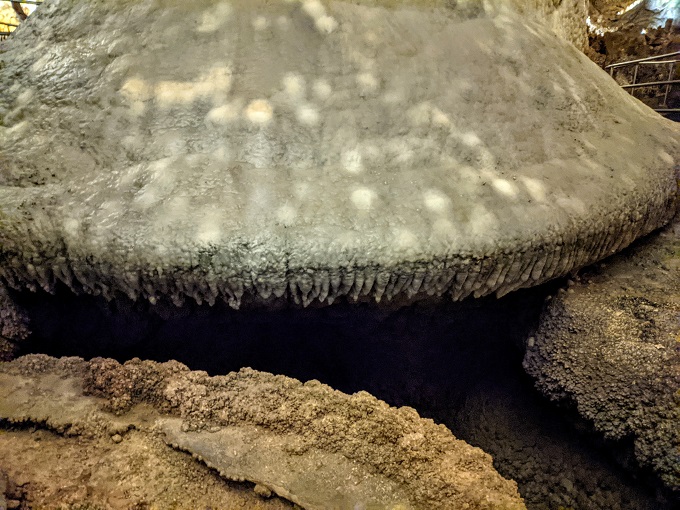
There was another formation I couldn’t help but notice – I’ll leave it to you to come up with a name for it.
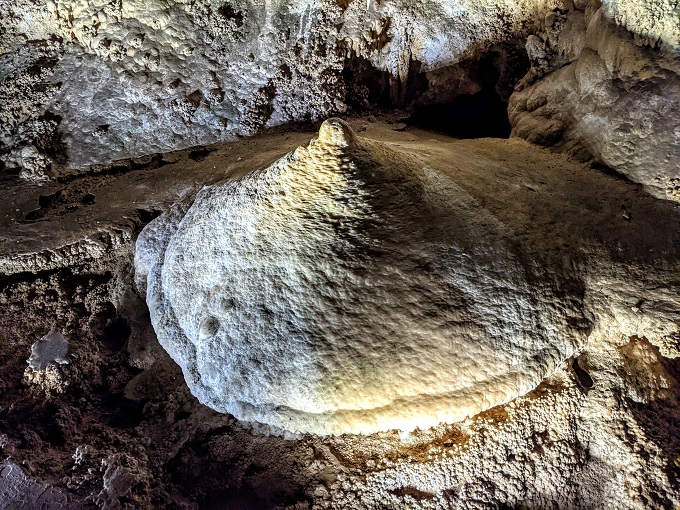
It felt like the 1.2 mile long route through the Big Room never ended. That’s not a complaint as it meant there were so many formations to see.
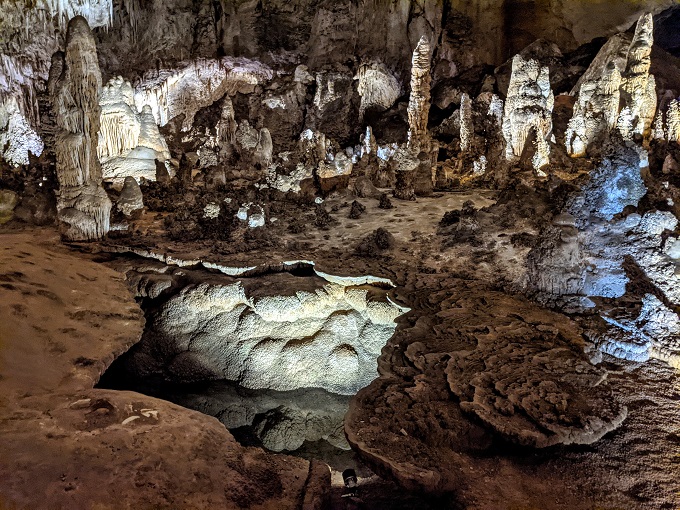
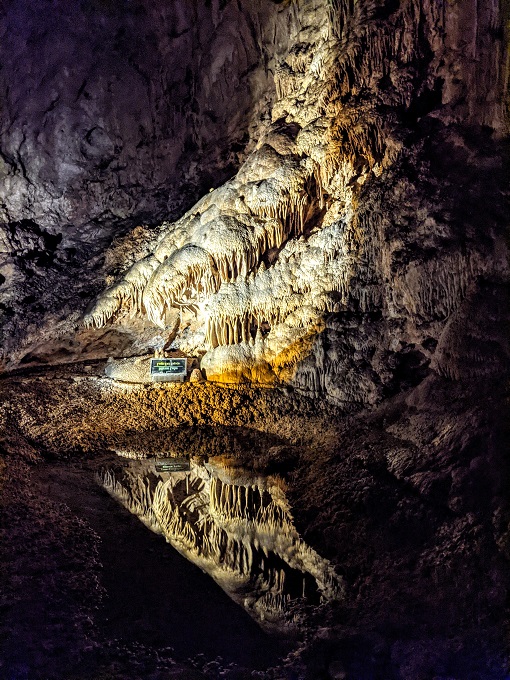
You can still see a ladder that was used by Jim White, although I don’t think I’d want to attempt descending into the cavern on it.
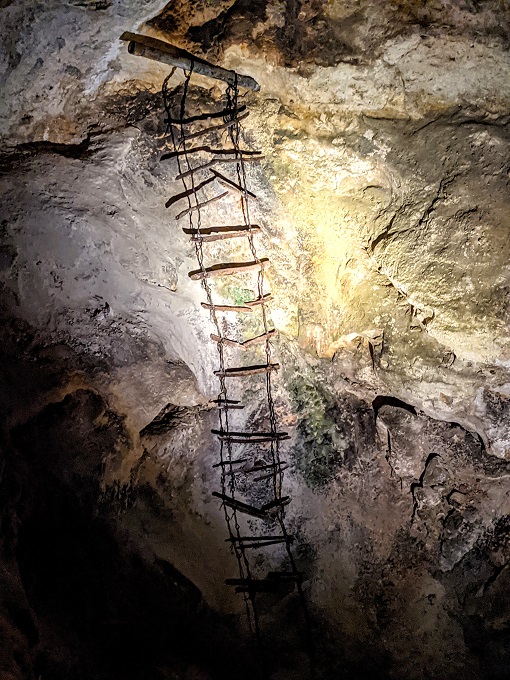
Another formation later on was called Rock of Ages, but it looked more like Godzilla to me.
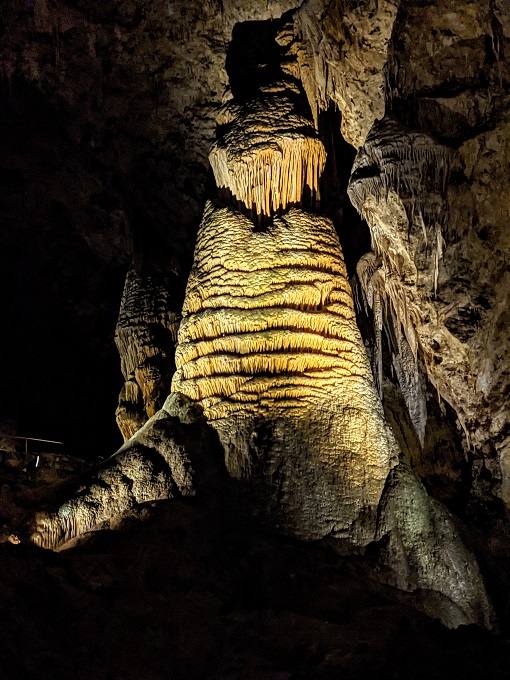
To try to give some sense of how immense the Big Room was, I took the video below. This is just from standing in one spot though – there’s so much more to see down there.
We eventually made it to the end. The Big Room is the culmination of your Carlsbad Caverns experience, but you have a couple of choices as to how to return to the surface.
Some people choose to walk all the way back up to the top along the path that you walked down. However, we weren’t too keen on the idea of walking up the equivalent of 75 flights of stairs on our way back up – especially while wearing our masks – so we took the elevator up the 750 feet instead.
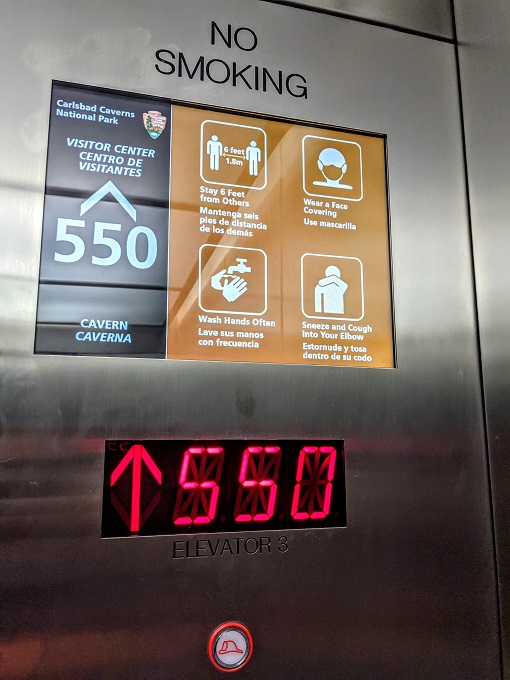
Carlsbad Caverns National Park has a museum exhibit area in the visitor center. Although most National Park visitor centers have been closed during COVID, the one at Carlsbad Caverns was open and so you could still look at the exhibits while walking through.
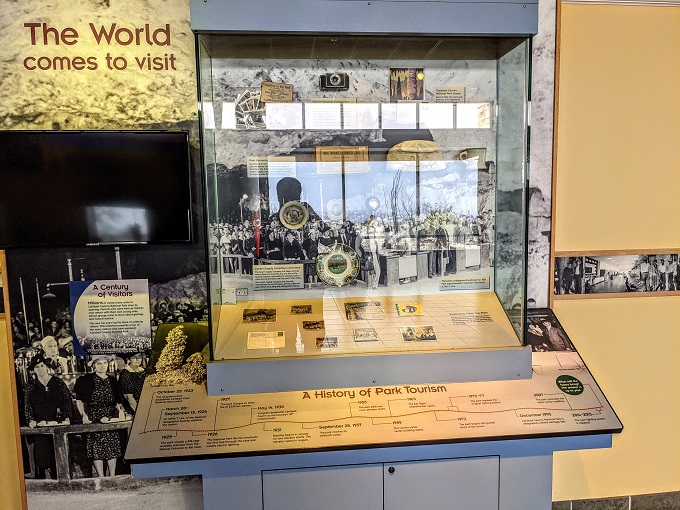
Before the current path was built down into the caverns, visitors would get lowered down in a bucket, with one such bucket being on display. As much as I would’ve wanted to visit the caverns back in the day, I think I would’ve passed on the opportunity if it meant having to sit in this bucket to get down there.
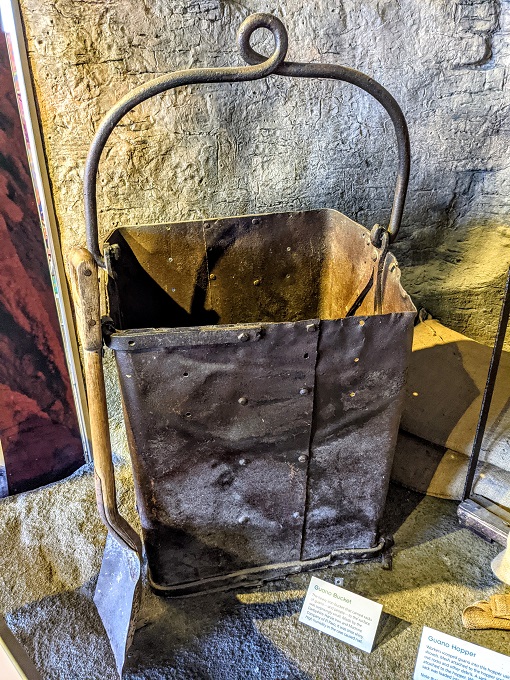
Final Thoughts
If you’ll be visiting New Mexico or northern Texas, a trip to Carlsbad Caverns is worth adding to your list of places to visit. The formations you see on the way down into the caverns aren’t too special, but that’s more than made up for by all the formations in the Big Room at the bottom, the largest cavern chamber in the US.
How To Get Carlsbad Caverns National Park Tickets
When Carlsbad Caverns reopened after being closed for quite some time due to COVID, entry was being restricted and tickets were issued on a first come, first served basis. That meant that if you didn’t arrive at the park early in the morning, you’d be out of luck.
Thankfully we got chatting to a family when we rode the Sandia Peak Tramway in Albuquerque who’d visited Carlsbad Caverns the week before. They mentioned that the ticketing process in-person had been an absolute mess and that as a result tickets were now available for booking online.
At the time of looking, the tickets weren’t being listed on the official National Parks website for the caverns. Instead, they were bookable through Recreation.gov using this link.
It cost $1 per person to reserve our tickets online which was a very small price to pay in order to be able to lock in our tickets. We had to pick a time to visit, so I chose 11:30am. You then have one hour from that time to arrive and enter the caverns; you don’t have to complete your visit that time, you just have to make sure you’ve entered within an hour of the time you choose.
At the time of writing this post, you can book tickets for up to one month ahead of time, but it’s worth booking ASAP because it looks like tickets for the next few days are already fully booked.
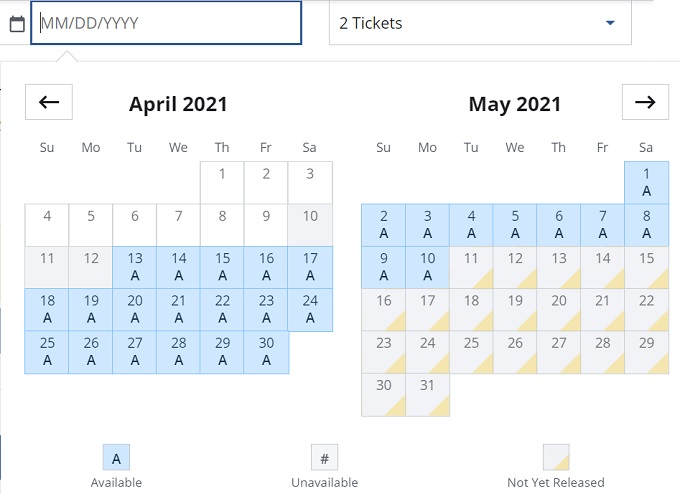
Note that these tickets were for self-guided tours; guided tours were still suspended due to COVID. The $1 only covers the online reservation fee too; there are separate entry fees for Carlsbad Caverns National Park.
At the time of writing this post, self-guided tours cost $15 per person for adults aged 16+, while it’s free for children ages 0-15. If you have an Annual Pass for National Parks, your entry is free other than the $1 per person fee if reserving your ticket online which is what we did.
[…] our way to Carlsbad Caverns National Park, we saw a sign for Sitting Bull Falls. I kept it in the back of my mind as something we could do […]